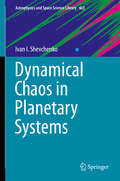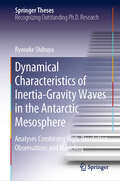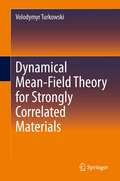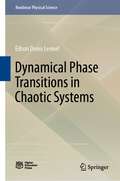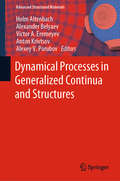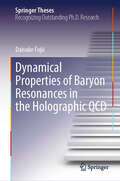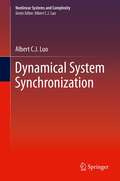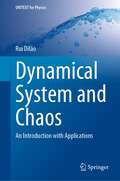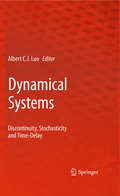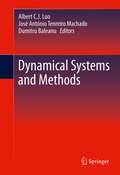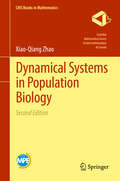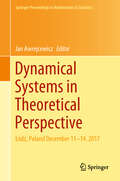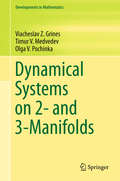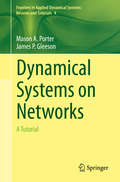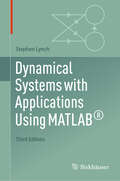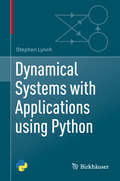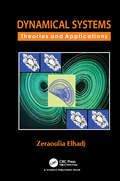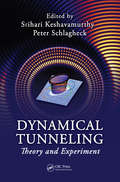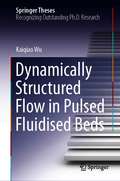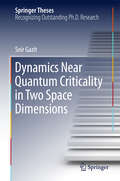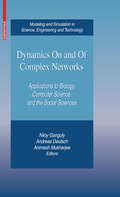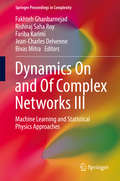- Table View
- List View
Dynamical Chaos in Planetary Systems (Astrophysics and Space Science Library #463)
by Ivan I. ShevchenkoThis is the first monograph dedicated entirely to problems of stability and chaotic behaviour in planetary systems and its subsystems. The author explores the three rapidly developing interplaying fields of resonant and chaotic dynamics of Hamiltonian systems, the dynamics of Solar system bodies, and the dynamics of exoplanetary systems. The necessary concepts, methods and tools used to study dynamical chaos (such as symplectic maps, Lyapunov exponents and timescales, chaotic diffusion rates, stability diagrams and charts) are described and then used to show in detail how the observed dynamical architectures arise in the Solar system (and its subsystems) and in exoplanetary systems. The book concentrates, in particular, on chaotic diffusion and clearing effects. The potential readership of this book includes scientists and students working in astrophysics, planetary science, celestial mechanics, and nonlinear dynamics.
Dynamical Characteristics of Inertia-Gravity Waves in the Antarctic Mesosphere: Analyses Combining High-Resolution Observations and Modeling (Springer Theses)
by Ryosuke ShibuyaThis book examines the origins and dynamical characteristics of atmospheric inertia-gravity waves in the Antarctic mesosphere. Gravity waves are relatively small-scale atmospheric waves with a restoring force of buoyancy that can transport momentum upward from the troposphere to the middle atmosphere. In previous studies, the dynamical characteristics of mesospheric gravity waves have not been fully examined using numerical simulations, since performing a numerical simulation with a high resolution and a high model-top requires considerable computational power. However, recent advances in computational capabilities have allowed us to perform numerical simulations using atmospheric general circulation models, which cover the troposphere to the mesosphere with a sufficiently fine horizontal resolution to resolve small-scale gravity waves. The book first describes the simulation of mesospheric gravity waves using a high-resolution non-hydrostatic atmospheric model with a high model top. The accuracy of the numerical results was confirmed by the first Mesosphere-Stratosphere-Troposphere/Incoherent Scattering (MST/IS) radar observation in the Antarctic. It also depicts the origins and propagation processes of mesospheric gravity waves on the basis of the results of the high-resolution numerical model. The behaviors of mesospheric gravity waves can be clearly explained using both fundamental and cutting-edge theories of fluid dynamics
Dynamical Mean-Field Theory for Strongly Correlated Materials
by Volodymyr TurkowskiThis is the first book that provides a detailed summary of one of the most successful new condensed matter theories - dynamical mean-field theory (DMFT) - in both static and dynamical cases of systems of different sizes. DMFT is one of the most successful approaches to describe the physical properties of systems with strong electron-electron correlations such as bulk materials, multi-layers, surfaces, 2D materials and nanostructures in both metallic and insulating phases. Strongly correlated materials usually include partially-filled localized d- or f-orbitals, and DMFT takes into account crucial for these systems time-resolved interaction between electrons when they “meet” on one atom and occupy one of these orbitals. The First Part of the book covers the general formalism of DMFT as a many-body theory, followed by generalizations of the approach on the cases of finite systems and out-of-equilibrium regime. In the last Chapter of the First Part we discuss generalizations of the approach on the case when the non-local interactions are taken into account. The Second Part of the book covers methodologies of merging DMFT with ab initio static Density Functional Theory (DFT) and Time-Dependent DFT (TDDFT) approaches. Such combined DFT+DMFT and DMFT+TDDFT computational techniques allow one to include the effects of strong electron-electron correlations at the accurate ab initio level. These tools can be applied to complex multi-atom multi-orbital systems currently not accessible to DMFT. The book helps broad audiences of students and researchers from the theoretical and computational communities of condensed matter physics, material science, and chemistry to become familiar with this state-of-art approach and to use it for reaching a deeper understanding of the properties of strongly correlated systems and for synthesis of new technologically-important materials.
Dynamical Phase Transitions in Chaotic Systems (Nonlinear Physical Science)
by Edson Denis LeonelThis book discusses some scaling properties and characterizes two-phase transitions for chaotic dynamics in nonlinear systems described by mappings. The chaotic dynamics is determined by the unpredictability of the time evolution of two very close initial conditions in the phase space. It yields in an exponential divergence from each other as time passes. The chaotic diffusion is investigated, leading to a scaling invariance, a characteristic of a continuous phase transition. Two different types of transitions are considered in the book. One of them considers a transition from integrability to non-integrability observed in a two-dimensional, nonlinear, and area-preserving mapping, hence a conservative dynamics, in the variables action and angle. The other transition considers too the dynamics given by the use of nonlinear mappings and describes a suppression of the unlimited chaotic diffusion for a dissipative standard mapping and an equivalent transition in the suppression of Fermi acceleration in time-dependent billiards. This book allows the readers to understand some of the applicability of scaling theory to phase transitions and other critical dynamics commonly observed in nonlinear systems. That includes a transition from integrability to non-integrability and a transition from limited to unlimited diffusion, and that may also be applied to diffusion in energy, hence in Fermi acceleration. The latter is a hot topic investigated in billiard dynamics that led to many important publications in the last few years. It is a good reference book for senior- or graduate-level students or researchers in dynamical systems and control engineering, mathematics, physics, mechanical and electrical engineering.
Dynamical Processes in Generalized Continua and Structures (Advanced Structured Materials #103)
by Holm Altenbach Victor A. Eremeyev Anton Krivtsov Alexander Belyaev Alexey V. PorubovThis book presents a collection of chapters on the current problems of the theory of dynamical processes in generalized continua and structures, and has been compiled to commemorate the 70th birthday of Prof. Dmitry Indeitsev – a leading specialist in the field of dynamical processes in solids, fluids and structures. It discusses various applications related to Prof. Indeitsev’s contributions, including various discrete and continuous dynamic models of structures and media, as well as a number of dynamical processes in generalized media.
Dynamical Processes on Complex Networks
by Alain Barrat Marc Barthélemy Alessandro VespignaniThe availability of large data sets have allowed researchers to uncover complex properties such as large scale fluctuations and heterogeneities in many networks which have lead to the breakdown of standard theoretical frameworks and models. Until recently these systems were considered as haphazard sets of points and connections. Recent advances have generated a vigorous research effort in understanding the effect of complex connectivity patterns on dynamical phenomena. For example, a vast number of everyday systems, from the brain to ecosystems, power grids and the Internet, can be represented as large complex networks. This new and recent account presents a comprehensive explanation of these effects.
Dynamical Processes on Complex Networks
by Alain Barrat Marc Barthélemy Alessandro VespignaniThe availability of large data sets have allowed researchers to uncover complex properties such as large scale fluctuations and heterogeneities in many networks which have lead to the breakdown of standard theoretical frameworks and models. Until recently these systems were considered as haphazard sets of points and connections. Recent advances have generated a vigorous research effort in understanding the effect of complex connectivity patterns on dynamical phenomena. For example, a vast number of everyday systems, from the brain to ecosystems, power grids and the Internet, can be represented as large complex networks. This new and recent account presents a comprehensive explanation of these effects.
Dynamical Properties of Baryon Resonances in the Holographic QCD (Springer Theses)
by Daisuke FujiiThis book focuses on the study of the dynamical properties of hadron resonances, especially their transition processes by electromagnetic and strong interactions, by using the holographic quantum chromodynamics (QCD) model. Understanding the nature of hadrons leads to revealing non-perturbative phenomena that are prominent in the low-energy region of QCD. However, there remain many open questions regarding the nature of resonant states. Holographic QCD is one of the most powerful methods to elucidate non-perturbative phenomena in QCD. We will attempt to investigate the dynamical properties of hadron resonances using the Sakai-Sugimoto model, which has achieved much success in the study of hadron physics. In particular, we studied the transition process of hadrons through the calculation of the form factors of them employing the approach of holographic QCD. The book contains a systematic review of the treatment of hadron physics by the Sakai-Sugimoto model. It further covers how to calculate the form factors of baryons through the calculation of the n-point function from holographic QCD. It also includes remarks on the modern understanding of hadron physics. The method of collective coordinate quantization of solitons—Skyrmion and Instanton—is also explained in a concise manner. These are useful not only for students and young researchers interested in this field.
Dynamical System Synchronization
by Albert C. LuoDynamical System Synchronization (DSS) meticulously presents for the first time the theory of dynamical systems synchronization based on the local singularity theory of discontinuous dynamical systems. The book details the sufficient and necessary conditions for dynamical systems synchronizations, through extensive mathematical expression. Techniques for engineering implementation of DSS are clearly presented compared with the existing techniques.
Dynamical System and Chaos: An Introduction with Applications (UNITEXT for Physics)
by Rui DilãoThis textbook introduces the language and the techniques of the theory of dynamical systems of finite dimension for an audience of physicists, engineers, and mathematicians at the beginning of graduation. Author addresses geometric, measure, and computational aspects of the theory of dynamical systems. Some freedom is used in the more formal aspects, using only proofs when there is an algorithmic advantage or because a result is simple and powerful. The first part is an introductory course on dynamical systems theory. It can be taught at the master's level during one semester, not requiring specialized mathematical training. In the second part, the author describes some applications of the theory of dynamical systems. Topics often appear in modern dynamical systems and complexity theories, such as singular perturbation theory, delayed equations, cellular automata, fractal sets, maps of the complex plane, and stochastic iterations of function systems are briefly explored for advanced students. The author also explores applications in mechanics, electromagnetism, celestial mechanics, nonlinear control theory, and macroeconomy. A set of problems consolidating the knowledge of the different subjects, including more elaborated exercises, are provided for all chapters.
Dynamical Systems
by Albert C. LuoDynamical Systems: Discontinuous, Stochasticity and Time-Delay provides an overview of the most recent developments in nonlinear dynamics, vibration and control. This book focuses on the most recent advances in all three areas, with particular emphasis on recent analytical, numerical and experimental research and its results. Real dynamical system problems, such as the behavior of suspension systems of railways, nonlinear vibration and applied control in coal manufacturing, along with the multifractal spectrum of LAN traffic, are discussed at length, giving the reader a sense of real-world instances where these theories are applied. Dynamical Systems: Discontinuous, Stochasticity and Time-Delay also contains material on time-delay systems as they relate to linear switching, dynamics of complex networks, and machine tools with multiple boundaries. It is the ideal book for engineers and academic researchers working in areas like mechanical and control engineering, as well as applied mathematics.
Dynamical Systems and Methods
by Albert C. Luo José António Machado Dumitru BaleanuNonlinear Systems and Methods For Mechanical, Electrical and Biosystems presents topics observed at the 3rd Conference on Nonlinear Science and Complexity(NSC), focusing on energy transfer and synchronization in hybrid nonlinear systems. The studies focus on fundamental theories and principles,analytical and symbolic approaches, computational techniques in nonlinear physical science and mathematics. Broken into three parts, the text covers: Parametrical excited pendulum, nonlinear dynamics in hybrid systems, dynamical system synchronization and (N+1) body dynamics as well as new views different from the existing results in nonlinear dynamics, mathematical methods for dynamical systems including conservation laws, dynamical symmetry in nonlinear differential equations and invex energies and nonlinear phenomena in physical problems such as solutions, complex flows, chemical kinetics, Toda lattices and parallel manipulator. This book is useful to scholars, researchers and advanced technical members of industrial laboratory facilities developing new tools and products.
Dynamical Systems in Population Biology
by Xiao-Qiang ZhaoPopulation dynamics is an important subject in mathematical biology. A cen#65533; tral problem is to study the long-term behavior of modeling systems. Most of these systems are governed by various evolutionary equations such as difference, ordinary, functional, and partial differential equations (see, e. g. , [165, 142, 218, 119, 55]). As we know, interactive populations often live in a fluctuating environment. For example, physical environmental conditions such as temperature and humidity and the availability of food, water, and other resources usually vary in time with seasonal or daily variations. Therefore, more realistic models should be nonautonomous systems. In particular, if the data in a model are periodic functions of time with commensurate period, a periodic system arises; if these periodic functions have different (minimal) periods, we get an almost periodic system. The existing reference books, from the dynamical systems point of view, mainly focus on autonomous biological systems. The book of Hess [106J is an excellent reference for periodic parabolic boundary value problems with applications to population dynamics. Since the publication of this book there have been extensive investigations on periodic, asymptotically periodic, almost periodic, and even general nonautonomous biological systems, which in turn have motivated further development of the theory of dynamical systems. In order to explain the dynamical systems approach to periodic population problems, let us consider, as an illustration, two species periodic competitive systems dUI dt = !I(t,Ul,U2), (0.
Dynamical Systems in Theoretical Perspective: Poland December 11 -14 2017 (Springer Proceedings in Mathematics & Statistics #248)
by Jan AwrejcewiczThis book focuses on theoretical aspects of dynamical systems in the broadest sense. It highlights novel and relevant results on mathematical and numerical problems that can be found in the fields of applied mathematics, physics, mechanics, engineering and the life sciences. The book consists of contributed research chapters addressing a diverse range of problems. The issues discussed include (among others): numerical-analytical algorithms for nonlinear optimal control problems on a large time interval; gravity waves in a reservoir with an uneven bottom; value distribution and growth of solutions for certain Painlevé equations; optimal control of hybrid systems with sliding modes; a mathematical model of the two types of atrioventricular nodal reentrant tachycardia; non-conservative instability of cantilevered nanotubes using the Cell Discretization Method; dynamic analysis of a compliant tensegrity structure for use in a gripper application; and Jeffcott rotor bifurcation behavior using various models of hydrodynamic bearings.
Dynamical Systems on 2- and 3-Manifolds
by Viacheslav Z. Grines Timur V. Medvedev Olga V. PochinkaThis book provides an introduction to the topological classification of smooth structurally stable diffeomorphisms on closed orientable 2- and 3-manifolds. The topological classification is one of the main problems of the theory of dynamical systems and the results presented in this book are mostly for dynamical systems satisfying Smale's Axiom A. The main results on the topological classification of discrete dynamical systems are widely scattered among many papers and surveys. This book presents these results fluidly, systematically, and for the first time in one publication. Additionally, this book discusses the recent results on the topological classification of Axiom A diffeomorphisms focusing on the nontrivial effects of the dynamical systems on 2- and 3-manifolds. The classical methods and approaches which are considered to be promising for the further research are also discussed. The reader needs to be familiar with the basic concepts of the qualitative theory of dynamical systems which are presented in Part 1 for convenience. The book is accessible to ambitious undergraduates, graduates, and researchers in dynamical systems and low dimensional topology. This volume consists of 10 chapters; each chapter contains its own set of references and a section on further reading. Proofs are presented with the exact statements of the results. In Chapter 10 the authors briefly state the necessary definitions and results from algebra, geometry and topology. When stating ancillary results at the beginning of each part, the authors refer to other sources which are readily available.
Dynamical Systems on Networks
by Mason A. Porter James P. GleesonThis volume is a tutorial for the study of dynamical systems on networks. It discusses both methodology and models, including spreading models for social and biological contagions. The authors focus especially on "simple" situations that are analytically tractable, because they are insightful and provide useful springboards for the study of more complicated scenarios. This tutorial, which also includes key pointers to the literature, should be helpful for junior and senior undergraduate students, graduate students, and researchers from mathematics, physics, and engineering who seek to study dynamical systems on networks but who may not have prior experience with graph theory or networks. Mason A. Porter is Professor of Nonlinear and Complex Systems at the Oxford Centre for Industrial and Applied Mathematics, Mathematical Institute, University of Oxford, UK. He is also a member of the CABDyN Complexity Centre and a Tutorial Fellow of Somerville College. James P. Gleeson is Professor of Industrial and Applied Mathematics, and co-Director of MACSI, at the University of Limerick, Ireland.
Dynamical Systems with Applications Using MATLAB®
by Stephen LynchThis textbook, now in its third edition, provides a broad and accessible introduction to both continuous and discrete dynamical systems, the theory of which is motivated by examples from a wide range of disciplines. It emphasizes applications and simulation utilizing MATLAB®, Simulink®, the Image Processing Toolbox®, the Symbolic Math Toolbox®, and the Deep Learning Toolbox®. The text begins with a tutorial introduction to MATLAB that assumes no prior programming knowledge. Discrete systems are covered in the first part, after which the second part explores the study of continuous systems using delay, ordinary, and partial differential equations. The third part considers chaos control and synchronization, binary oscillator computing, Simulink, and the Deep Learning Toolbox. A final chapter provides examination- and coursework-type MATLAB questions for use by instructors and students. For the Third Edition, all the material has been thoroughly updated in line with the most recent version of MATLAB, R2025a. New chapters have been added on artificial neural networks, delay differential equations, numerical methods for ordinary and partial differential equations, and the Deep Learning Toolbox. MATLAB program files, Simulink model files, and other materials are available to download from the author&’s website and through GitHub. The hands-on approach of Dynamical Systems with Applications using MATLAB® has minimal prerequisites, only requiring familiarity with ordinary differential equations. It will appeal to advanced undergraduate and graduate students, applied mathematicians, engineers, and researchers in a broad range of disciplines such as population dynamics, biology, chemistry, computing, economics, nonlinear optics, neural networks, and physics. Praise for the Second Edition: &“This book [is] a valuable reference to the existing literature on dynamical systems, especially for the remarkable collection of examples and applications selected from very different areas, as well as for its treatment with MATLAB of these problems.&” -- Fernando Casas, zbMATH &“[The] vast compilation of applications makes this text a great resource for applied mathematicians, engineers, physicists, and researchers. Instructors will be pleased to find an aims and objectives section at the beginning of each chapter where the author outlines its content and provides student learning objectives.&” -- Stanley R. Huddy, MAA Reviews
Dynamical Systems with Applications using Python
by Stephen LynchThis textbook provides a broad introduction to continuous and discrete dynamical systems. With its hands-on approach, the text leads the reader from basic theory to recently published research material in nonlinear ordinary differential equations, nonlinear optics, multifractals, neural networks, and binary oscillator computing. Dynamical Systems with Applications Using Python takes advantage of Python’s extensive visualization, simulation, and algorithmic tools to study those topics in nonlinear dynamical systems through numerical algorithms and generated diagrams.After a tutorial introduction to Python, the first part of the book deals with continuous systems using differential equations, including both ordinary and delay differential equations. The second part of the book deals with discrete dynamical systems and progresses to the study of both continuous and discrete systems in contexts like chaos control and synchronization, neural networks, and binary oscillator computing. These later sections are useful reference material for undergraduate student projects. The book is rounded off with example coursework to challenge students’ programming abilities and Python-based exam questions. This book will appeal to advanced undergraduate and graduate students, applied mathematicians, engineers, and researchers in a range of disciplines, such as biology, chemistry, computing, economics, and physics. Since it provides a survey of dynamical systems, a familiarity with linear algebra, real and complex analysis, calculus, and ordinary differential equations is necessary, and knowledge of a programming language like C or Java is beneficial but not essential.
Dynamical Systems: Theories and Applications
by Zeraoulia ElhadjChaos is the idea that a system will produce very different long-term behaviors when the initial conditions are perturbed only slightly. Chaos is used for novel, time- or energy-critical interdisciplinary applications. Examples include high-performance circuits and devices, liquid mixing, chemical reactions, biological systems, crisis management, secure information processing, and critical decision-making in politics, economics, as well as military applications, etc. This book presents the latest investigations in the theory of chaotic systems and their dynamics. The book covers some theoretical aspects of the subject arising in the study of both discrete and continuous-time chaotic dynamical systems. This book presents the state-of-the-art of the more advanced studies of chaotic dynamical systems.
Dynamical Tunneling: Theory and Experiment
by Srihari Keshavamurthy Peter SchlagheckA prominent aspect of quantum theory, tunneling arises in a variety of contexts across several fields of study, including nuclear, atomic, molecular, and optical physics and has led to technologically relevant applications in mesoscopic science. Exploring mechanisms and consequences, Dynamical Tunneling: Theory and Experiment presents the work of i
Dynamically Structured Flow in Pulsed Fluidised Beds (Springer Theses)
by Kaiqiao WuThis book analyses the use of a pulsed gas flow to structure bubbling gas-solid fluidised beds and to induce a special fluidisation state, called "dynamically structured flow", as a promising approach to process intensification. It explores the properties of bubbles rising in staggered periodic arrays without direct interaction, assessing their size, separation, and velocity, and explains how a highly uniform, scalable flow offers tight control over the system hydrodynamics. These features are desirable, as they not only bypass engineering challenges occurring in traditional operations, such as maldistribution and non-uniform contact, but also allow to decouple conflicting design objectives, such as mixing and gas-solid contact. The thesis also presents computational simulations which reveal the periodic transitions of the particulate phase between fluid-like and solid-like behaviour. This book will be of interest to researchers, engineers, and graduate students alike, particularly those working in industrial drying, combustion, and chemical production.
Dynamics Near Quantum Criticality in Two Space Dimensions
by Snir GazitThis work addresses dynamical aspects of quantum criticality in two space dimensions. It probes two energy scales: the amplitude (Higgs) mode, which describes fluctuations of the order parameter amplitude in the broken symmetry phase and the dual vortex superfluid stiffness. The results demonstrate that the amplitude mode can be probed arbitrarily close to criticality in the universal line shape of the scalar susceptibility and the optical conductivity. The hallmark of quantum criticality is the emergence of softening energy scales near the phase transition. In addition, the author employs the charge-vortex duality to show that the capacitance of the Mott insulator near the superfluid to insulator phase transition serves as a probe for the dual vortex superfluid stiffness. The numerical methods employed are described in detail, in particular a worm algorithm for O(N) relativistic models and methods for numerical analytic continuation of quantum Monte Carlo data. The predictions obtained are particularly relevant to recent experiments in cold atomic systems and disordered superconductors.
Dynamics Of Quantised Vortices In Superfluids
by Edouard B. SoninA comprehensive overview of the basic principles of vortex dynamics in superfluids, this book addresses the problems of vortex dynamics in all three superfluids available in laboratories (4He, 3He, and BEC of cold atoms) alongside discussions of the elasticity of vortices, forces on vortices, and vortex mass. Beginning with a summary of classical hydrodynamics, the book guides the reader through examinations of vortex dynamics from large scales to the microscopic scale. Topics such as vortex arrays in rotating superfluids, bound states in vortex cores and interaction of vortices with quasiparticles are discussed. The final chapter of the book considers implications of vortex dynamics to superfluid turbulence using simple scaling and symmetry arguments. Written from a unified point of view that avoids complicated mathematical approaches, this text is ideal for students and researchers working with vortex dynamics in superfluids, superconductors, magnetically ordered materials, neutron stars and cosmological models.
Dynamics On and Of Complex Networks
by Animesh Mukherjee Andreas Deutsch Niloy GangulyThis self-contained book systematically explores the statistical dynamics on and of complex networks having relevance across a large number of scientific disciplines. The theories related to complex networks are increasingly being used by researchers for their usefulness in harnessing the most difficult problems of a particular discipline. The book is a collection of surveys and cutting-edge research contributions exploring the interdisciplinary relationship of dynamics on and of complex networks. Topics covered include complex networks found in nature--genetic pathways, ecological networks, linguistic systems, and social systems--as well as man-made systems such as the World Wide Web and peer-to-peer networks. The contributed chapters in this volume are intended to promote cross-fertilization in several research areas, and will be valuable to newcomers in the field, experienced researchers, practitioners, and graduate students interested in systems exhibiting an underlying complex network structure in disciplines such as computer science, biology, statistical physics, nonlinear dynamics, linguistics, and the social sciences.
Dynamics On and Of Complex Networks III: Machine Learning and Statistical Physics Approaches (Springer Proceedings in Complexity)
by Bivas Mitra Fakhteh Ghanbarnejad Rishiraj Saha Roy Fariba Karimi Jean-Charles DelvenneThis book bridges the gap between advances in the communities of computer science and physics--namely machine learning and statistical physics. It contains diverse but relevant topics in statistical physics, complex systems, network theory, and machine learning. Examples of such topics are: predicting missing links, higher-order generative modeling of networks, inferring network structure by tracking the evolution and dynamics of digital traces, recommender systems, and diffusion processes.The book contains extended versions of high-quality submissions received at the workshop, Dynamics On and Of Complex Networks (doocn.org), together with new invited contributions. The chapters will benefit a diverse community of researchers. The book is suitable for graduate students, postdoctoral researchers and professors of various disciplines including sociology, physics, mathematics, and computer science.
